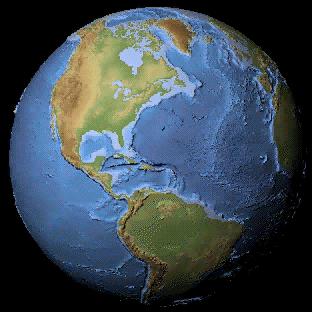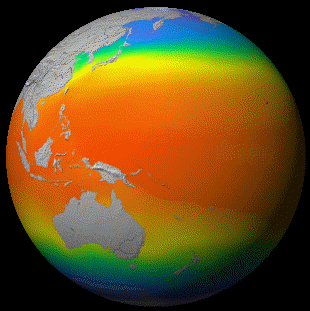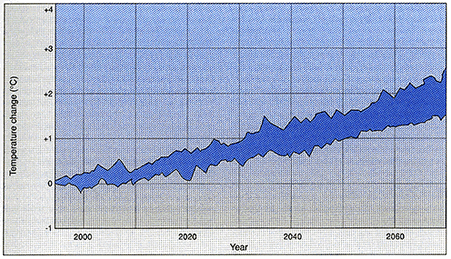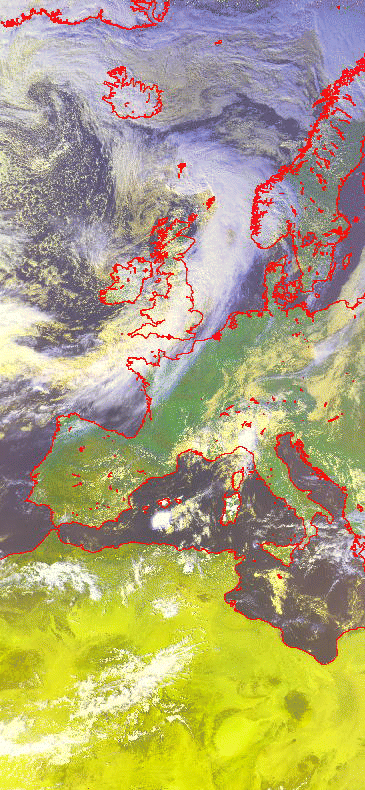Spheres of Influence:
The Earth's Differentiation Into Solid, Liquid, and Gas Layers
by Neil Sitron and Dan Goldstein

Introduction
Any person examining their surroundings immediately realizes the
vastness of what envelopes him. However, the visible objects of the Earth
pale in comparison to what is going on, unseen and unnoticed. The Earth
around us is divided into three layers, the gas layer (atmosphere), liquid
layer (hydrosphere), and solid layer (land). These layers developed and
evolved over the course of billions of years and are still changing today.
More importantly, these layers perform constant mutations of the planet
and interact with each other. The three layers, solid, liquid, and gas
form the basis of what we call Planet Earth.
History of the Earth's Layers
The Earth, as we know it today, consists of three separate states
of matter: solid, liquid, and gas. They are better known as land, sea,
and air. Initially though, during its infancy, the Earth was a part-molten
planet with very primitive and less clearly defined forms of each layer.
The differentiation that occurred to bring about the modern day Earth took
billions of years and involved several complex processes.
One must first examine the formation of land. At first, Earth was a
large melt, from which a nickel and iron core developed. Eventually, a
solid silicate mantle evolved. The mantle became the foundation from which
the crust, or modern day land, was formed. To explain the crust's evolution,
it was proposed that the crust of the continents originated from a particular
mantle. The average continental crust has properties quite similar to those
of granite, but the mantle has properties closer to ocean-floor basalt
and chondritic meteorites. Through a process called "chemical fractionation",
a concentration of relatively light elements distilled from the basalt
mantle to form a granitic residue. This residue comprised approximately
7-8% of the original mantle. As the mantle underwent this process, numerous
amounts of light elements including silicon, oxygen, potassium, sodium,
aluminum, carbon, nitrogen, hydrogen, helium, and calcium rose to the surface
to form a primitive crust. Through these elements, the most familiar rock-producing
minerals of today were formed including alkali feldspar (KAlSi3O8 and NaAlSi3O8),
quartz (SiO2), and pyroxenes (Ca [Mg, Fe] Si2O6). A complete list of these
minerals can be found in Table 1.
Table 1

(Batten & Dott, 126)
This original continental crust did not become stable until nearly 1
billion years after the separation of the mantle from the core. During
its period of instability, Earth was much hotter and saw several times
more radioactive decay than today. As a result, some crust would form,
melt, and re-form again. As the Earth cooled down, however, this process
ceased, and the current crust has been stable for roughly 3.5 billion years.
The evolution of the Earth's atmosphere poses more of a mystery than
that of the crust. In an effort to develop an accurate explanation, geologists
have decided to compare our present atmosphere with that of large planets,
such as Jupiter and the meteorites. Planetologists believe that the larger
planets, Jupiter especially, retained the greatest percentage of original
gases from the initial atmospheres of the planets. Table 2 lists the components
of Earth's atmosphere and compares them to Jupiter's and the gases found
on meteorites. The meteorites are widely believed to resemble the early
protoplanets, so studying their various gases provides important clues
to the Earth's past.
Table 2

(Batten & Dott, 128)
In analyzing the atmosphere's evolution, two popular hypotheses exist,
both assuming that considerable free hydrogen and helium have drifted into
space over time because of their small atomic masses. The great mystery
that both of these hypotheses attempt to explain is the emergence of free
oxygen, something that has not occurred on either Jupiter or the meteorites.
The first hypothesis is called the Photochemical Dissociation Hypothesis.
Based on studies of Jupiter, it assumes that the original atmosphere contained
the same primary gases that Jupiter does- ammonia, methane and water vapor.
The original atmosphere contained no free oxygen nor did it contain ozone.
As a result, high-energy, ultraviolet radiation could easily penetrate
the atmosphere at will. One property of such intense radiation is its ability
to trigger photochemical, or light-induced, reactions. The Photochemical
Dissociation Hypothesis states that these reactions caused the evolution
of the atmosphere through the following four step process:
Step 1: The ultraviolet lights combined with the water vapor to set
the hydrogen off into space and free the oxygen.
2H2O + uv light energy ----> 2H2 (freed into space) + O2
Step 2: The newly freed oxygen reacted with methane, forming carbon
dioxide and additional water vapor.
CH4 + 2O2 ----> CO2 + 2H2O
Step 3: The oxygen also reacted with ammonia, producing nitrogen and
water.
4NH3 + 3O2 ----> 2N2 + 6H2O
Step 4: After converting the ammonia and methane to carbon dioxide and
nitrogen, free oxygen began to accumulate as further dissociation of water
vapor continued.
This hypothesis states that once the water vapor reacted with the intense
radiation, oxygen was freed, allowing the creation of nitrogen and carbon
dioxide. Together, these three elements form the main consituents of the
modern day atmosphere.
The Outgassing Hypothesis presents an alternative to the Photochemical
Dissociation Hypothesis. It states that most of the atmospheric gases arose
from the interior by a process called "outgassing". Through outgassing,
a gaseous transfer occurred between the Earth's interior and its surface,
mainly through igneous activity. A perfect example of outgassing today
comes from volcanoes. When volcanoes erupt, they expel steam, carbon dioxide,
nitrogen, hydrogen and carbon monoxide into the air. So, according to the
hypothesis, before volcanoes even existed, some other process occurred
which launched gases such as nitrogen, carbon dioxide and water vapor into
the atmosphere.
In contrast to the Photochemical Dissociation Hypothesis, the Outgassing
Hypothesis argues that the free oxygen came from the photosynthesis of
primitive organisms which existed 1.5 - 3.5 billion years ago. The oxygen
took approximately 2 billion years to become free, but when it did, it
formed the ozone layer, eliminating the dangerous radiation and setting
up the foundation for a habitable planet.
In either example, the formation of the atmosphere no doubt included
the presence of water vapor. This water vapor, in turn, accumulated and
liquefied to form the seas and oceans that today comprise over two thirds
of the Earth's surface. Geologists do not concern themselves so much with
how the water vapor liquefied; instead, they tend to focus on the rate
at which the water accumulated over time. Initially, it was assumed that
the water grew at a constant rate over time. Others believed that the rate
of accumulation of sea water would depend exclusively on atmospheric production.
The atmospheric production, in turn, depended on chemical fractionation,
based on the hypothesis' link between the Earth's interior and atmospheric
gases of nitrogen, carbon dioxide and water vapor. Thus, it was reasoned
that the rate of accumulation grew (and still does grow) in direct proportion
to an inferred increase of the volume of the continental crust over time.
Geologists have compared estimates analyzing the rate of releases of
helium and argon from the interior into the atmosphere. It is believed
that if water was released at a comparable rate, then the water would accumulate
over a long period of time, but not at a constant rate. Most likely, crustal
growth and outgassing were far more rapid earlier in the Earth's history
as a result of the immense radioactivity that existed. Table 3 shows a
graph of the water accumulating at a constant rate and plots it against
the proposed accumulation rate. As a result, the water accumulated at a
faster rate as well and has gradually increased at a decreasing rate over
the past 2 billion years.
SOLID LAYER

A computer-generated model isolating the Geosphere, picturing the
world as if the Hydrosphere did not exist
(http://www.ea.com/Creative_Wonders/AtlasPages/Geosp.html)
The exterior of the Earth represents the planet's solid layer. Its
base is formed by the uppermost part of the mantle, known as the lithosphere
which contains the rigid material of the outer portion of the Earth. The
lithosphere possesses a thin, rocky outer layer called the crust. The crust
ranges in thickness, from 30-60 kilometers thick beneath the continents
to only 5-10 kilometers thick beneath the oceans. Bedrock of the crust
is covered by loose rock particles called the regolith that forms when
bedrock reacts with the atmosphere and hydrosphere. When nature transports
regolith to a different location, the regolith is re-named sediment, which
means "settling". The upper portion of regolith creates soil,
which permits the growth of plants and crops that are crucial for human
survival.
The regions on the Earth where life can evolve belong to the biosphere.
The biosphere is defined as all the Earth's living matter as well as all
dead plants and animals that have not yet been completely decomposed. The
biosphere has a maximum range of 20 kilometers in thickness and ranges
from the depths of the oceans to the peaks of the highest mountains. It
is primarily composed of various compounds of carbon, hydrogen and oxygen.
Continents, or continental masses, refer to the major land areas of
the world. Continental masses comprise roughly 30% of the surface of the
Earth and average approximately 800 meters in altitude. The continents
are underlain by ancient rocks, dating as far back in time as 3.9 billion
years. An interesting point, however, is that the materials which comprise
the continents all resulted from the geological cycle that transformed
the Earth from its primitive state to its modern one. No remnants of any
materials from the Earth's infant stage have ever been found in the continents.
Research has shown that the most accurate way to analyze the continents
is to organize them into several large regions where the surface morphology
and the various rocks display similar traits. These regions are called
physiographic provinces. Examples include mountains, plains, plateaus,
and shields.
A mountain is a physiographic province defined as a landmass that stands
400 meters higher or more than its surroundings. Cordilleras, a Spanish
term meaning "strings", is a pseudonym for the various mountain
belts of the Earth. A cordilleras has several individual parts based on
morphology, including mountain ranges, mountain systems, and mountain chains.
Plains represent a second type of physiographic province. Because of
the minimal variations between their lowest and highest points, plains
are quite flat. Beneath the plains are sediments, and the addition of new
layers of these sediments causes the surface area of plains to grow. Plains
are most often found in coastal regions or large regions within the interiors
of the continents. A high-standing area within which the rock strata are
generally horizontal is a third physiographic province called a plateau.
Plateaus can be viewed as elevated plains. Usually, they result when the
sediments underlying a former plains area cement together and subsequently
elevate. Not all plateaus are underlain by sediments; some are formed by
layers of volcanic rocks. Shields, the fourth physiographic province, are
low-lying regions which form when several ancient mountain belts join together.
Shield areas are relatively thick and rigid continental blocks. The regions
on the Earth where life can evolve belong to the biosphere. The biosphere
is defined as "the totality of the Earth's living matter and, in addition,
dead plants and animals that have not yet been completely decomposed."
The biosphere has a maximum range of 20 kilometers in thickness and ranges
from the depths of the oceans to the peaks of the highest mountains. It
is primarily composed of various compounds of carbon, hydrogen, and oxygen.
The Liquid Layer
 A
computer-generated model of the Hydrosphere detailing the average daily
temperature of the Earth's water supply
A
computer-generated model of the Hydrosphere detailing the average daily
temperature of the Earth's water supply
(http://www.ea.com/Creative_Wonders/AtlasPages/Geosp.html)
The liquid layer of the Earth is called the hydrosphere and it represents
the entire conglomeration of water bodies enveloping the earth's surface.
The hydrosphere consists of the rivers, streams, lakes and oceans, while
its sub-category, the cryosphere, is made up of the temporarily frozen,
solid water bodies such as ice, snow and glaciers. The liquid layer of
the earth covers approximately three-quarters of the earth's surface, of
which oceans comprise ninety-seven percent. The distribution of the liquid
layer of the earth is shown on Table 4.
The daily changes in the liquid layer is explained by the "hydrologic
cycle." The Sun's heat evaporates the water of the hydrosphere. The
newly-created water vapor rises into the atmosphere, cools, condenses,
and becomes precipitation, falling back onto the land and into the oceans,
lakes, and rivers. The hydrologic cycle describes the movement of water
in its three states: solid, liquid and gas. The evaporation and precipitation
of the water, the hydrosphere of planet Earth, recycles and rejuvenates
the Earth and its water supply each and every day. Evaporation and precipitation
across the Earth is in total balance, though evaporation is greater than
precipitation over the oceans and the reverse is true over the land. Water
vapor usually averages twelve days in the atmosphere before coming back
down to Earth again as rain or snow. This difference is corrected by the
flow of rivers into the oceans and balance is maintained.
Table 3

(Batten & Dott, 131)
The hydrosphere has three main functions which make it so important
to the planet Earth. First, water shapes the earth's surface by eroding
certain areas and relocating those materials. Ocean waves are a primary
instrument of erosion. Surf zone abrasion is an example of this. The sediment
carried by the waves smashes into the beach and the constant action wears
down the surf zone, smoothing and flattening the land.
Second, the oceans serve as basins for the accumulation of almost all
of the substances available on Earth. The rivers of the hydrosphere collect
materials and sediment and bring them out to the interconnected oceans.
As a result, fine-grained, course-grained and evaporite sediments can all
be found in the oceans. Also, terrigenous sediment, materials eroded by
waves, carried by rivers, and blown by the wind, combine with pelagic sediment--marine
organic materials referred to as deep-sea ooze--dissolve into the ocean
waters and collect on the ocean floor. However, the hydrosphere is not
just pure water. Through erosion and movement of sediment, several compounds
have become dissolved in the water. Three to four percent of ocean water
is mineral matter in solution, of which seventy-five percent is sodium
chloride (NaCl--common table salt). Most of this mineral matter is contained
in the oceans and only a minimal amount exists in the lakes and streams.
Most importantly, the hydrosphere's third function is to be used as
an essential building block and sustainer of virtually all life forms.
However, one must not ignore the fact that although most people think of
this as virtually the only important function of the liquid layer, the
importance is actually in the proper operation of all of the functions
and the successful interaction of the hydrosphere and the solid and gas
layers.
The Gas Layer
The outermost layer of Earth is the gas layer, better known as
the atmosphere. The atmosphere is composed primarily of nitrogen and oxygen,
but is also comprised of several trace gases such as carbon dioxide (CO2)
and water vapor. All of these gases, which together form what is commonly
called "air", are held to the Earth by the pull of gravity and
each serves an important function. Carbon dioxide gas provides a barrier
which keeps heat from escaping the Earth; this is known as the "greenhouse
effect." The "greenhouse effect" caused by carbon dioxide
in the atmosphere serves to maintain a temperature on Earth great enough
to sustain life. Yet, if the amount of carbon dioxide gas were to increase
drastically, too much heat would be trapped in the atmosphere, making it
too hot for many organisms to survive. This causes a frightful problem
wherein a certain balance of CO2 gas must be maintained to ensure that
life may be maintained on the planet. Carbon dioxide also serves as the
lifeline to most plants, allowing them to breath by taking in the carbon
dioxide and emitting oxygen gas. Another gas, ozone (O3) screens out the
harmful ultraviolet rays emanating from the sun. One of the most abundant
gases in the atmosphere, oxygen, is needed for animals to breath and live.
 This graph shows the range
of predictions made as to the global-mean surface temperature during the
next eighty years
This graph shows the range
of predictions made as to the global-mean surface temperature during the
next eighty years
(http://gcrio.ciesin.org/CONSEQUENCES/fall95/fig1.html)
The gas layer is constantly moving around the Earth in the form of
wind and filling the openings of the solid layer of Earth that have not
yet been penetrated by water. The movement of wind is created by the uneven
pattern of the Sun's heat on Earth, wherein the heat is greater near the
equator than at the poles. This causes the equatorial air to expand, become
less dense, and move toward the poles, where it will cool, contract, become
more dense and flow toward the equator. However, the Coriolis effect modifies
this pattern by forcing the air to clump into wind belts. The Coriolis
effect causes any body that moves freely with respect to the rotating solid
of the Earth to veer toward the right in the Northern Hemisphere and towards
the left in the Southern Hemisphere. The Coriolis effect manipulates the
movement of the Earth's gaseous layer and the flow of air becomes curved
east in the north and west in the south instead of merely moving north
and south between the poles.  A
satellite image of cloud movements and formations over Europe, with the
political boundaries artificially superimposed
A
satellite image of cloud movements and formations over Europe, with the
political boundaries artificially superimposed
(http://www.orbimage.com/seastar/appsdocs/clodapps.htm)
The atmosphere works as a geological agent of movement and erosion in
two ways: wind and rock weathering. Winds are often extremely violent and
can do extensive damage and erode land in a short period of time. Rock
weathering, though, also erodes land but in a much slower process. Rock
weathering slowly loosens material so that streams, gravity, and other
instruments may carry it to the oceans.
The atmosphere's interaction with the hydrosphere, the liquid layer
of the Earth, is extremely important, as the gas layer holds water vapor
(water in a gaseous state, caused by heat from the sun) and redistributes
it back to the Earth's surface. The gas layer's role in the hydrologic
cycle is to carry the evaporated water and cool it back down, then release
it as precipitation. Without an atmosphere, water vapor would merely escape
into space and the Earth's water supply would deplete. The atmosphere is
the reason why rain is possible on the planet Earth.
Conclusion
The differentiation process that occurred on Earth was both lengthy
and complicated. Over the course of nearly 4.5 billion years, the Earth
has transformed from a molten protoplanet to a world with clear, beautiful
oceans, majestic mountains, and an atmosphere that can sustain human, animal,
and plant life. While the process was tedious, the results are undeniable.
Had the Earth not differentiated into solid, liquid, and gas layers, life
never would have evolved. But will life as we know it continue forever
on Earth? Today's research suggests otherwise. Most scientists believe
that several billion years from now the sun will burn out, killing any
and all life forms remaining on the Earth. A more immediate problem faces
the life-forms on Earth. Because of human negligence, (mainly in the form
of pollution), the solid, liquid, and gas layers of the Earth are being
threatened. The extent of the damage is unknown at this time. Should humans
continue, however, to pollute the oceans, destroy the land and erode the
ozone layer, the consequences will be frightening. The differentiation
process took billions of years; reversing it may not take as long.
Glossary of Terms
Atmosphere : The gas layer of the Earth, primarily consisting
of nitrogen, oxygen, carbon dioxide, and water vapor.
Bedrock : Large quantities of solid rock which form the primary
composition of the crust.
Chemical Fractionation : A concentration of relatively light
elements which distilled to form a granitic residue.
Continental Masses : The major land areas of the world.
Cordilleras : Spanish for "strings". Refers to the
Earth's mountain belts.
Corlolis Effect : Effect that causes any body of air that moves
freely with respect to the rotating solid of Earth to move towards the
right in the Northern Hemisphere and towards the left in the Southern Hemisphere
Cryosphere : A sub-category of the hydrosphere consisting of
the temporarily frozen, solid water bodies including snow, ice, and glaciers.
Greenhouse Effect : Occurs when carbon dioxide gas provides a
barrier which keeps heat from escaping the Earth. It serves to maintain
a temperature on Earth great enough to sustain life.
Hydrologic Cycle : The cyclic movement of water through evaporation,
precipitation, wind transport, stream flow, percolation, and related processes.
Hydrosphere : The liquid layer of the Earth. The entire conglomeration
of water bodies enveloping the Earth's surface.
Lithosphere : The uppermost portion of the Earth's mantle.
Outgassing Hypothesis : Hypothesis which states that atmosphere
gases arose from the interior of the Earth through igneous activity, such
as volcanoes.
Photochemical Dissociation Hypothesis : Hypothesis which states
that intense ultraviolet radiation triggered photochemical reactions which
caused the evolution of the modern-day atmosphere on Earth.
Physiographic Province : A large continental region where the
surface morphology and various rocks display similar traits to each other.
Plains : A physiographic province with little variation between
its lowest and highest points.
Plateau : A physiographic province. It is a high standing area
whose rock strata are horizontal.
Regolith : A sheet of loose particles covering the bedrock. It
plays a vital role in plant growth by creating soil.
Rock Weathering : A form of erosion which slowly loosens material
so that streams, gravity, and other instruments carry it to the oceans.
Sediment : Regolith which is transported to a different location
by nature.
Surf Zone Abrasion : One method of shaping the Earth's surface
caused by ocean waves which erode certain areas.
Resources
Batten, Roger L. and Robert H. Dott. Evolution of the Earth.
New York: McGraw-Hill Book Company, 1971.
Landes, Kenneth K. Physical Geology and Man. New York: Prentice-Hall,
Inc., 1948.
Menard, H.W. Geology, Resources, and Society. San Francisco:
W.H. Freeman and Company, 1974.
Porter, Steven C. and Brian J. Skinner. The Dynamic Earth. New
York: John Wiley and Sons, 1989.
Sanders, John E. Principles of Physical Geology. New York: John
Wiley and Sons, 1981.
This page is maintained by Neil
Sitron and Dan Goldstein.




 A
computer-generated model of the Hydrosphere detailing the average daily
temperature of the Earth's water supply
A
computer-generated model of the Hydrosphere detailing the average daily
temperature of the Earth's water supply 